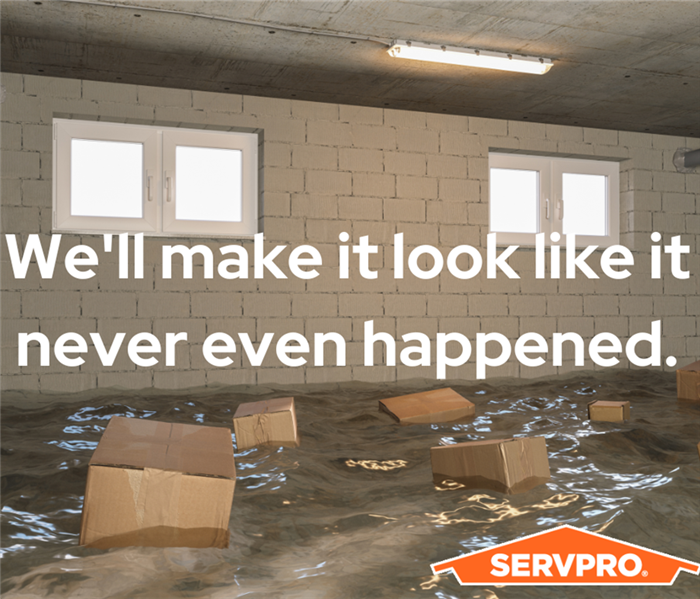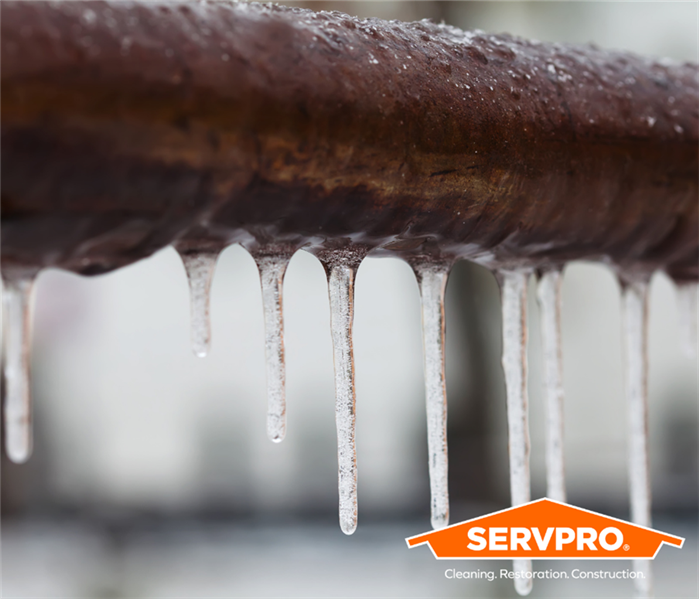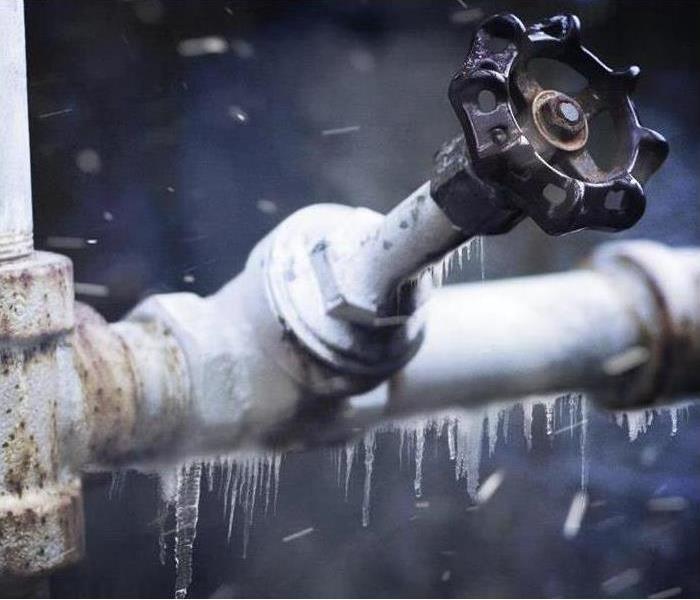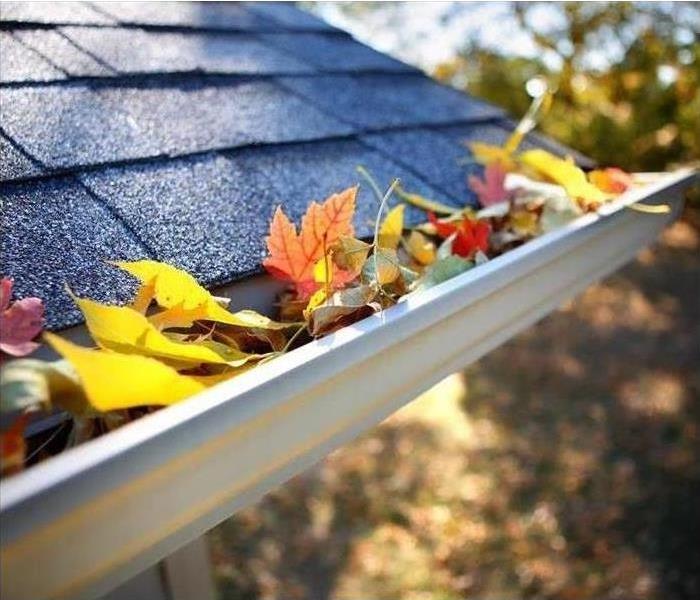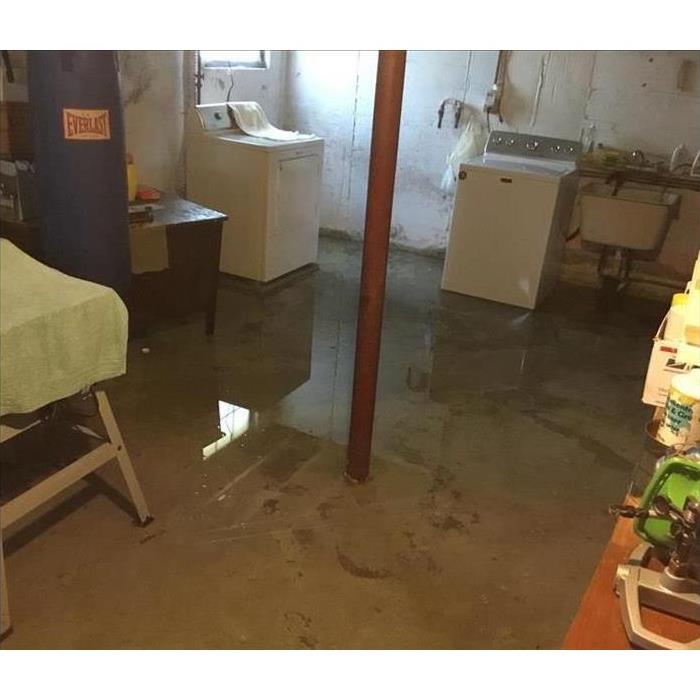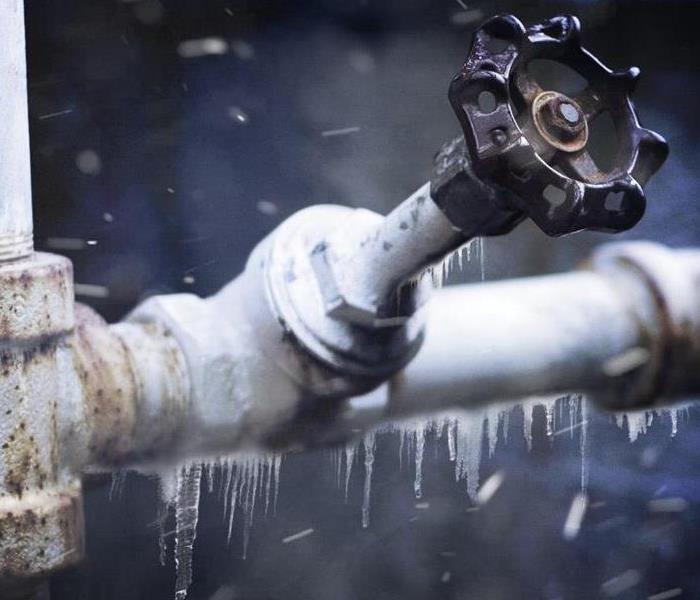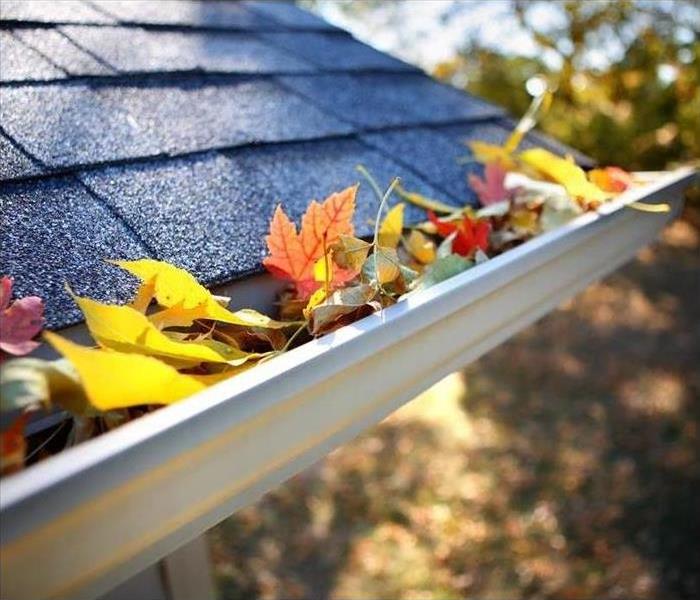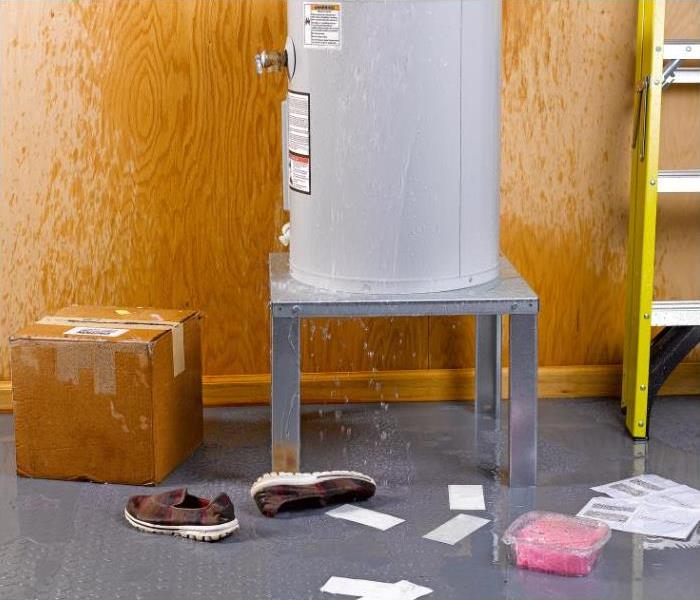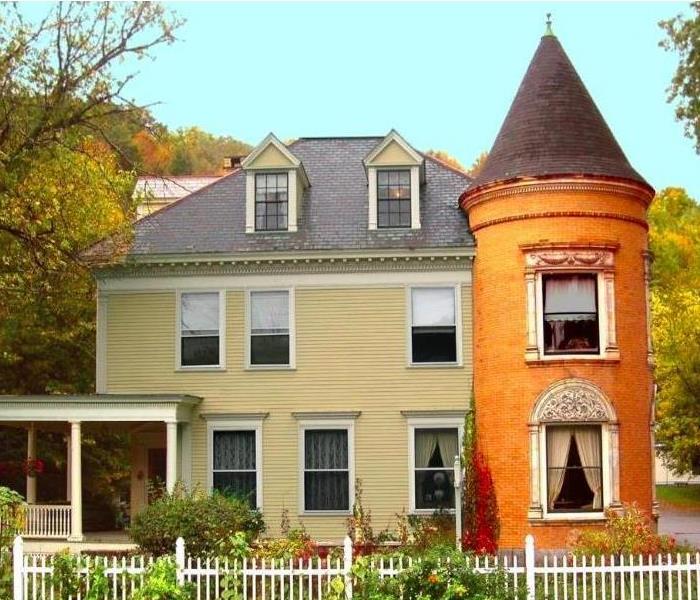Recent Water Damage Posts
What to Do If Your Water Heater Fails: A Step-by-Step Guide to Handling Water Damage
11/5/2024 (Permalink)
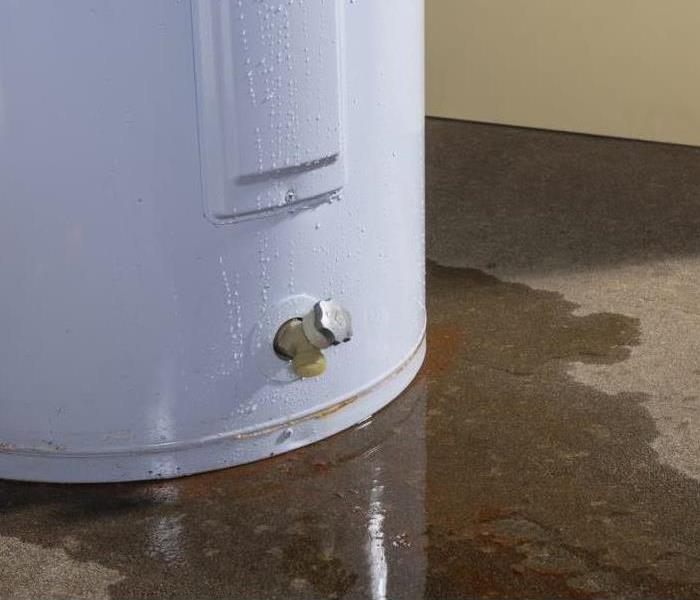 What to Do If Your Water Heater Fails
What to Do If Your Water Heater Fails
A malfunctioning or burst water heater can lead to extensive water damage in your home or business. Whether your water heater fails suddenly or is showing signs of wear, it's important to act quickly to minimize damage and prevent further issues. SERVPRO of Marshfield/Rockland is here to guide you through the essential steps to take if your water heater goes out, as well as how our water damage restoration services can help you get back on track.
1. Turn Off the Water Supply The first step when dealing with a failed or leaking water heater is to stop the flow of water. This will help prevent further flooding and water damage in your home or business.
- Locate your water shut-off valve. For most homes, this will be near the water heater itself, but it may also be located at the main water line leading into the building.
- Turn the valve clockwise to shut off the water supply. If you're unsure where the shut-off valve is, look for a main shut-off valve near your water meter or in the basement or crawlspace.
2. Turn Off the Power or Gas Supply If your water heater is electric, the next step is to cut the power to the unit to avoid electrical hazards. If you have a gas water heater, you'll need to turn off the gas supply.
- For electric water heaters, locate your circuit breaker panel and switch off the breaker that powers the water heater.
- For gas water heaters, find the gas valve and turn it off. You may also want to consult your water heater’s manual or a professional if you're unsure how to safely turn off the gas.
3. Assess the Damage Once the water supply and power have been turned off, carefully assess the extent of the damage. Depending on the situation, you may experience everything from a minor leak to a full flood. Check the area around the water heater for standing water, damp carpets, wet walls, or water pooling in nearby rooms.
- If you notice significant water damage or standing water, it’s important to take quick action to prevent mold growth and structural damage.
4. Remove Excess Water and Moisture If the water is still leaking or has already flooded a room, it’s crucial to remove excess water as quickly as possible. You can use a wet/dry vacuum, towels, or a mop to soak up as much water as you can.
- If the flooding is extensive, it’s best to call in professionals like SERVPRO of Marshfield/Rockland, who have the equipment and expertise to remove large amounts of water efficiently and safely.
- If you can’t access the water heater area immediately or if there’s too much water to handle alone, call a professional to start the restoration process immediately.
5. Dry Out the Area Once the standing water has been removed, the next step is to dry out the area to prevent further damage and the potential for mold growth. Use fans, dehumidifiers, and open windows to promote airflow and moisture evaporation.
- SERVPRO of Marshfield/Rockland uses industrial-grade air movers and dehumidifiers to dry out affected areas, ensuring that water-damaged areas are properly dried and reducing the chances of mold and mildew growth.
6. Call a Professional Water Damage Restoration Service Water damage restoration isn’t a DIY job, especially if it involves significant flooding or moisture exposure to structural elements such as drywall, insulation, or flooring. That's where SERVPRO of Marshfield/Rockland can help.
- Our IICRC-certified water damage restoration experts are trained to assess the full scope of the damage and restore your home or business to its pre-damage condition.
- We provide services like water extraction, drying, mold remediation (if necessary), and the repair or replacement of damaged materials like drywall and flooring.
7. Contact a Plumber or HVAC Specialist While SERVPRO of Marshfield/Rockland can handle the water damage restoration, you’ll also need a licensed plumber or HVAC professional to address the root cause of the problem—your water heater.
- A plumber can assess whether the water heater needs repairs or if it requires replacement.
- If your water heater has been damaged beyond repair, a professional can help you select and install a new unit to avoid future issues.
8. Prevent Future Water Heater Failures To avoid dealing with water heater problems again in the future, it’s important to take preventive steps:
- Regular Maintenance: Have your water heater serviced annually to check for signs of wear, leaks, or sediment buildup.
- Inspect for Leaks: Periodically inspect the area around your water heater for any signs of leaks or pooling water.
- Install a Leak Detection System: Consider installing a water leak detection system or a water heater pan to catch small leaks before they cause significant damage.
A failed water heater can cause significant water damage, but acting quickly and following the right steps can help minimize the impact. Whether it's turning off the water supply, assessing the damage, or calling in a professional for restoration, SERVPRO of Marshfield/Rockland is here to help. If you’ve experienced water damage from a broken water heater, our experienced team can quickly respond to assess, clean, and restore your property to its pre-damage condition.
Don’t let water damage from a faulty water heater cause lasting problems—contact SERVPRO of Marshfield/Rockland for fast and reliable water damage restoration services today.
What To Do When You Experience Water Damage
11/28/2023 (Permalink)
What to do until help arrives:
After any water damage situation, your primary focus should be safety:
- Is it safe to stay in the house?
- Electrical and "slip and fall" hazards are some of the most prevalent concerns.
- Only do activities that are safe for you to perform.
- Wet materials can be VERY heavy. Be careful!
What to do after Flooding:
- Remove excess water by mopping and blotting.
- Wipe excess water from wood furniture after the removal of lamps and tabletop items.
- Remove and prop wet upholstery and cushions.
- Place aluminum foil or wood blocks between furniture legs and wet carpeting.
- Turn air conditioning on for maximum drying in summer.
- Remove colored rugs from wet carpeting.
- Remove art objects to a safe, dry place.
- Gather loose items from floors.
What NOT to do after Flooding:
- Don't leave wet fabrics in place. Hang furs and leather goods.
- Don't leave books, magazines or other colored items on wet carpet or floors.
- Don't use your household vacuum to remove water.
- Don't use television or other household appliances.
- Don't turn on ceiling fixtures if the ceiling is wet, and keep out of rooms where ceilings are sagging.
SERVPRO of Marshfield/Rockland is available 24/7 with the help you need. Call us at (781) 834-7707!
Rug Water Damage Prevention
11/28/2023 (Permalink)
The best thing you can do to save that area rug you love so much, is to roll it up BEFORE the storm. If you’ve been warned of possible flooding, take the extra time to put away your mats and area rugs that you can.
Textiles wet for over 24 hours should be considered trash, as they are unrecoverable and have already started getting mold and bacteria. That being said, when the water is out of your control, there is hope for your carpets - if you act quickly.
Carpet recovery is NOT a do-it-yourself job. Immediately call a professional. While waiting, you can sop up excess water with towels and remove any large debris from the floor. Do not lift carpet that is tacked to the floor, this can cause shrinkage that can ruin the product. While carpet padding often cannot be dried quickly enough to prevent spore growth, calling SERVPRO of Marshfield/Rockland for their professional drying services can be your best chance of saving your carpet.
Don’t Stress About Water Damage Remediation
1/4/2023 (Permalink)
We have the water removal equipment and experience to make it look like it never even happened.
When you realize your tub overflowed or the water heater leaked all over your basement, you want to dry your home as fast as possible. Too often, homeowners call us after deterioration sets in instead of when the initial event took place. We have the proper equipment needed to keep such harm from happening to your home.
Protecting your home from the harsh effects of water damage often requires the use of water removal and drying equipment. Water that escaped from pipes and basins and soaked into floors and other surfaces inside your property does not disappear from your home merely because you no longer see it. Just as it can soak into things, it can also evaporate into the air and move to other areas of your home.
Water that becomes water vapor can condense on other surfaces and cause damage. Damage can begin to take place within only a few hours of the initial incident. However, the effects might not become apparent for some time. The damage that can happen as a result of water left to work its way around your home costs much more than removing the water before such damage can ruin your home and contents. We use equipment that draws the water out of these spaces.
SERVPRO of Marshfield/Rockland uses these and other useful tools to mitigate homes when water removal must take place. Preventing damage from occurring saves our customers expense and aggravation. Contact us at 781-834-7707 for all your water removal and damage needs.
Tips For Water Damage in your Marshfield Home or Business
11/3/2022 (Permalink)
What to do until help arrives:
After any water damage situation, your primary focus should be safety:
- Is it safe to stay in the house?
- Electrical and "slip and fall" hazards are some of the most prevalent concerns.
- Only do activities that are safe for you to perform.
- Wet materials can be VERY heavy. Be careful!
What to do after Flooding:
- Remove excess water by mopping and blotting.
- Wipe excess water from wood furniture after the removal of lamps and tabletop items.
- Remove and prop wet upholstery and cushions.
- Place aluminum foil or wood blocks between furniture legs and wet carpeting.
- Turn air conditioning on for maximum drying in summer.
- Remove colored rugs from wet carpeting.
- Remove art objects to a safe, dry place.
- Gather loose items from floors.
What NOT to do after Flooding:
- Don't leave wet fabrics in place. Hang furs and leather goods.
- Don't leave books, magazines or other colored items on wet carpet or floors.
- Don't use your household vacuum to remove water.
- Don't use television or other household appliances.
- Don't turn on ceiling fixtures if the ceiling is wet, and keep out of rooms where ceilings are sagging.
SERVPRO of Marshfield/Rockland is available 24/7 with the help you need. Call us at (781) 834-7707!
Marshfield Residents: We Specialize in Flooded Basement Cleanup and Restoration!
11/3/2022 (Permalink)
A basement can flood at any time, although flooding most often occurs during heavy rainfall. Basements are inherently prone to flooding because they are the lowest level of a building and are normally built partly or entirely below ground level. There are a number of reasons why your Marshfield or Rockland basement could flood, including:
- A blocked or failed sewer lateral pipe
- Heavy rain causes surface water to pool around your home
- Storm sewer backup
- Sanitary sewer backup
- Foundation drainage failure
- Water supply-line break or hot-water tank failure
- And many more
If flood water is not handled quickly and properly, it can jeopardize your health and safety, and cause severe damage to your home’s structure. Remember, the longer you wait, the worse the problem will get.
The bottom line: a flooded basement can jeopardize your health, safety, and your home’s integrity. It’s worth making a call to SERVPRO of Marshfield/Rockland and let our trained, professional crews handle the situation safely and correctly. We have earned the trust of hundreds of homeowners, business owners, and property professionals.
We are Flooded Basement Specialists:
- We are Available 24 hours/7 days per week
- We’re a Preferred Vendor to many National Insurance Companies
- We Bill The Insurance Directly – One Less Thing For You To Worry About
- Our Technicians are Highly-Trained in Water Restoration Techniques
- We use s500 IICRC Restoration Standards
- Advanced Inspection and Extraction Equipment
Basement Flooded? Call Us Today – We’re Ready To Help! - (781) 834-7707
Understanding Basement Flooding
7/26/2022 (Permalink)
Returning home after walking the dog, a day at work, or a much-needed vacation, can quickly turn into a nightmare upon discovering a basement full of water. How you handle this emergency not only affects the level of damage your home may sustain, but also the safety of those you love.
What to do when your basement floods?
Start with these steps:
- Shut off electricity and gas to the area. If you’re not sure how, call an electrician or SERVPRO, who can get someone out to you right away. The most important thing to remember is to never enter a flooded area when the power is on.
- Try to determine the source of the water. Excessive rainfall or a burst pipe are two top reasons why your basement may flood.
- If safe to proceed, and while wearing protective gear like boots, gloves and a mask, enter the water to investigate the source further. If your basement has a drain and you can safely navigate to it, check to see if it is clogged.
- Time to get that water out of there. Depending on the amount of water, this may be as simple as using towels, a mop, or a wet vacuum. If the flooding is more extensive, a sump pump is necessary. Once the bulk of the water has been removed, soak up all remaining moisture with towels.
- Assess damage. Remove any items, like furniture, that appear damaged by the water and move them to a space where they can dry. If the drying process on items is taking longer than a couple days, unfortunately, they may not be able to be salvaged. Any items that were within boxes should be removed to air out, and all items should be monitored for mildew growth.
- Get the air moving in the basement to dry it out. Open windows and doors, and use fans placed around the space to inspire quick drying of the flooded area. If you have a dehumidifier, move it to the basement to aid the drying process.
How to prevent your basement from flooding?
It’s easy to look back at the cause of a flooded basement and see where things went wrong, but what about preventing flooding before it occurs? There are some measures you can take today to help waterproof your basement and safeguard it against a catastrophic flooding episode.
- Keep your rain gutters clean, and make sure they’re pointed away from the foundation of your home.
- During the next heavy rain, check around your yard to see where water is pooling and being diverted to. If it’s going toward the foundation of your home, contact an expert to grade your yard so it’s able to properly handle the water it receives during storms.
- If you have a basement window, make sure it’s protected with a window well cover.
- A sump pump can be your basement’s savior. An automatic sump pump set to trigger on when it senses water in your basement space offers a layer of protection for your home, even when you’re not there. Homeowners in particularly flood-prone areas should have a backup sump pump, and check to see if flood insurance is available for purchase.
When to call for help with basement flooding:
Calling a professional for help with a flooded basement is always a good idea, especially if the amount of water is more than a foot deep, many items have become wet, or mildew is beginning to take hold. Quickly removing the water and beginning the drying process is essential to lessen the possibility for mold to form, which can greatly increase the damage and cost involved.
We have the experience, qualifications and knowledge needed to help you quickly deal with a flooded basement cleanup, because we handle these types of jobs all the time. Let us deal with the stress and get your basement back in working order.
Give us a call at 781-834-7707 to get help with your water cleanup. We’ll take the worry for you.
Frozen Pipes
2/3/2022 (Permalink)
Plumbing breaks and flood damage can be incredibly costly, so preparation is key to keep your pipes from freezing. Follow these easy steps to prevent expensive plumbing repairs.
Water Main:
Locate your house’s water main shut-off valve. In case of a water emergency, you will need to shut off all water flow to the home, and this time-saving knowledge could save you thousands in case of a burst pipe.
Exterior Pipes:
Locate all outdoor spigots and drain. Drain and store all of your hoses. Locate all other exterior pipes and shut down supply lines. Install insulated pipe sleeves on exterior supply lines.
Attic, Basement and Crawl Space Pipes:
Install pipe sleeves on both cold and hot water pipes in attics, basements and crawl spaces.
Cold Air Entry Points:
Seal the outside of your home with caulk or insulation. Check your exterior envelope for air leaks and cracks to help prevent frozen pipes and boost heating efficiency in the winter.
Have water damage from a frozen pipe? Call Us Today at 781-834-7707.
Prevent Water Heater Leaks
1/31/2022 (Permalink)
Most of us rarely think about our hot water heaters until they either fail to give us hot water or they leak all over our basement and cause significant damage. But in fact, due to the nature of what they do, water heaters are prone to leaks and often can cause significant damage to your basement, especially if your basement is finished. Wet carpeting and drywall is a much harder cleanup process.
Hot water heaters operate by bringing cold water into the tank at the bottom. This water is then heated using natural gas, propane, fuel oil, or electricity. The hot water then rises to the top where it is released to wherever warm water is needed in your home, while more cold water comes back into the tank to replace it, and the cycle continues. This process results in various spots where water can leak.
- Whenever you have a plumbing connection or plumbing lines, you have the potential for a leak and there are several near your water heater
- Because water is being heated, water heaters have a temperature & pressure relief valve. These valves can be faulty and cause a leak, or they can leak due to excessive pressure, overheating, or becoming stuck
- Your water heater has a drain valve. This drain valve can fail to close completely and can cause a leak.
- If you have an electric water heater, leaks can occur due to a loose heating element or a bad gasket
- The tank itself can corrode and water can leak out the bottom
To protect yourself from significant water damage from a leaky hot water heater, you can install an automatic water shut-off valve. Moisture sensors are placed on the floor near or under the water heater. If a leak is detected, the sensors send a signal to the control box which in turn closes the valve, shutting off the water supply.
If you find yourself with water damage from a leaky water heater, call the experts at SERVPRO of Marshfield/Rockland at(781) 834-7707. Our water damage restoration experts can arrive and begin working quickly. Our goal is to make your basement "Like it never even happened."
Tips to Prepare for Winter
11/9/2021 (Permalink)
Plumbing breaks and flood damage can be incredibly costly, so preparation is key to keep your pipes from freezing. Follow these easy steps to prevent expensive plumbing repairs.
Water Main:
Locate your house’s water main shut-off valve. In case of a water emergency, you will need to shut off all water flow to the home, and this time-saving knowledge could save you thousands in case of a burst pipe.
Exterior Pipes:
Locate all outdoor spigots and drain. Drain and store all of your hoses. Locate all other exterior pipes and shut down supply lines. Install insulated pipe sleeves on exterior supply lines.
Attic, Basement and Crawl Space Pipes:
Install pipe sleeves on both cold and hot water pipes in attics, basements and crawl spaces.
Cold Air Entry Points:
Seal the outside of your home with caulk or insulation. Check your exterior envelope for air leaks and cracks to help prevent frozen pipes and boost heating efficiency in the winter.
Have water damage from a frozen pipe? Call Us Today at 781-834-7707.
Prevent Water Damage by Clearing Clogged Gutters
11/9/2021 (Permalink)
It’s that time of the year when leaves are falling from the trees and filling our gutters. It’s important to clean your gutters and remove the leaves, in order to prevent water problems in the winter and spring. Gutters clogged with leaves can cause 2 different water problems.
If your gutters are clogged with leaves, water from rain or melting snow cannot freely flow off your roof and an ice dam can form when the temperature dips below freezing. An ice dam is a ridge of ice that forms at the edge of a roof and prevents additional melting snow from draining off the roof. As the snow melts from your roof, either by the heat of the sun or by heat escaping from your home, it tends to refreeze at the edges and other juncture points of your roof. The refreezing water has a damming effect creating an even bigger ice dam behind it. Continuous feeding of the ice dam by melting and refreezing snowmelt can cause significant damage. As the water seeps under shingles it refreezes, expanding and creating an even bigger gap for future drainage to fill and further the cycle. Your shingles are being raised and eventually the water that backs up behind the dam, and underneath the shingles, can leak into your home and cause damage to walls, ceilings, insulation, and create a perfect environment for mold growth. In extreme cases, we have seen water pouring down into living areas when winter rain falls on the ice dam.
Ideally, you should clean your gutters twice a year, in the spring and in the fall. If you end up with water damage from clogged gutters or ice dams, give us a call at (781) 834-7707.
Tips For Water Damage in your Marshfield Home or Business
4/27/2021 (Permalink)
What to do until help arrives:
After any water damage situation, your primary focus should be safety:
- Is it safe to stay in the house?
- Electrical and "slip and fall" hazards are some of the most prevalent concerns.
- Only do activities that are safe for you to perform.
- Wet materials can be VERY heavy. Be careful!
What to do after Flooding:
- Remove excess water by mopping and blotting.
- Wipe excess water from wood furniture after the removal of lamps and tabletop items.
- Remove and prop wet upholstery and cushions.
- Place aluminum foil or wood blocks between furniture legs and wet carpeting.
- Turn air conditioning on for maximum drying in summer.
- Remove colored rugs from wet carpeting.
- Remove art objects to a safe, dry place.
- Gather loose items from floors.
What NOT to do after Flooding:
- Don't leave wet fabrics in place. Hang furs and leather goods.
- Don't leave books, magazines or other colored items on wet carpet or floors.
- Don't use your household vacuum to remove water.
- Don't use television or other household appliances.
- Don't turn on ceiling fixtures if the ceiling is wet, and keep out of rooms where ceilings are sagging.
SERVPRO of Marshfield/Rockland is available 24/7 with the help you need. Call us at (781) 834-7707.
Marshfield Residents: We Specialize in Flooded Basement Cleanup and Restoration!
4/27/2021 (Permalink)
A basement can flood at any time, although flooding most often occurs during heavy rainfall. Basements are inherently prone to flooding because they are the lowest level of a building and are normally built partly or entirely below ground level. There are a number of reasons why your Marshfield or Rockland basement could flood, including:
- A blocked or failed sewer lateral pipe
- Heavy rain causes surface water to pool around your home
- Storm sewer backup
- Sanitary sewer backup
- Foundation drainage failure
- Water supply-line break or hot-water tank failure
- And many more
At SERVPRO of Marshfield/Rockland, we have the expertise and equipment to properly restore your property. Our highly-trained technicians use advanced water damage inspection and extraction equipment. Our technicians thoroughly document the drying process so you can be assured that your property has been dried thoroughly. If recent storms have caused flooding or a pipe has burst, our technicians are ready 24 hours a day, 7 days a week, to immediately respond to flood or water damage at your South Shore property.
Have Questions about Basement Flooding? We specialize in flooded basement cleanup and restoration. Call SERVPRO of Marshfield/Rockland Today at - (781) 834-7707.
Understanding Basement Flooding
1/25/2021 (Permalink)
Returning home after walking the dog, a day at work, or a much-needed vacation, can quickly turn into a nightmare upon discovering a basement full of water. How you handle this emergency not only affects the level of damage your home may sustain, but also the safety of those you love.
What to do when your basement floods?
Start with these steps:
- Shut off electricity and gas to the area. If you’re not sure how, call an electrician or SERVPRO, who can get someone out to you right away. The most important thing to remember is to never enter a flooded area when the power is on.
- Try to determine the source of the water. Excessive rainfall or a burst pipe are two top reasons why your basement may flood.
- If safe to proceed, and while wearing protective gear like boots, gloves and a mask, enter the water to investigate the source further. If your basement has a drain and you can safely navigate to it, check to see if it is clogged.
- Time to get that water out of there. Depending on the amount of water, this may be as simple as using towels, a mop, or a wet vacuum. If the flooding is more extensive, a sump pump is necessary. Once the bulk of the water has been removed, soak up all remaining moisture with towels.
- Assess damage. Remove any items, like furniture, that appear damaged by the water and move them to a space where they can dry. If the drying process on items is taking longer than a couple days, unfortunately, they may not be able to be salvaged. Any items that were within boxes should be removed to air out, and all items should be monitored for mildew growth.
- Get the air moving in the basement to dry it out. Open windows and doors, and use fans placed around the space to inspire quick drying of the flooded area. If you have a dehumidifier, move it to the basement to aid the drying process.
How to prevent your basement from flooding?
It’s easy to look back at the cause of a flooded basement and see where things went wrong, but what about preventing flooding before it occurs? There are some measures you can take today to help waterproof your basement and safeguard it against a catastrophic flooding episode.
- Keep your rain gutters clean, and make sure they’re pointed away from the foundation of your home.
- During the next heavy rain, check around your yard to see where water is pooling and being diverted to. If it’s going toward the foundation of your home, contact an expert to grade your yard so it’s able to properly handle the water it receives during storms.
- If you have a basement window, make sure it’s protected with a window well cover.
- A sump pump can be your basement’s savior. An automatic sump pump set to trigger on when it senses water in your basement space offers a layer of protection for your home, even when you’re not there. Homeowners in particularly flood-prone areas should have a backup sump pump, and check to see if flood insurance is available for purchase.
When to call for help with basement flooding:
Calling a professional for help with a flooded basement is always a good idea, especially if the amount of water is more than a foot deep, many items have become wet, or mildew is beginning to take hold. Quickly removing the water and beginning the drying process is essential to lessen the possibility for mold to form, which can greatly increase the damage and cost involved.
We have the experience, qualifications and knowledge needed to help you quickly deal with a flooded basement cleanup, because we handle these types of jobs all the time. Let us deal with the stress and get your basement back in working order.
Give us a call at 781-834-7707 to get help with your water cleanup. We’ll take the worry for you.
Frozen Pipes – Tips to Prepare for Winter
1/11/2021 (Permalink)
Plumbing breaks and flood damage can be incredibly costly, so preparation is key to keep your pipes from freezing. Follow these easy steps to prevent expensive plumbing repairs.
Water Main:
Locate your house’s water main shut-off valve. In case of a water emergency, you will need to shut off all water flow to the home, and this time-saving knowledge could save you thousands in case of a burst pipe.
Exterior Pipes:
Locate all outdoor spigots and drain. Drain and store all of your hoses. Locate all other exterior pipes and shut down supply lines. Install insulated pipe sleeves on exterior supply lines.
Attic, Basement and Crawl Space Pipes:
Install pipe sleeves on both cold and hot water pipes in attics, basements and crawl spaces.
Cold Air Entry Points:
Seal the outside of your home with caulk or insulation. Check your exterior envelope for air leaks and cracks to help prevent frozen pipes and boost heating efficiency in the winter.
Have water damage from a frozen pipe? Call Us Today at 781-834-7707.
Prevent Water Damage by Clearing Clogged Gutters
11/2/2020 (Permalink)
It’s that time of the year when leaves are falling from the trees and filling our gutters. It’s important to clean your gutters and remove the leaves, in order to prevent water problems in the winter and spring. Gutters clogged with leaves can cause 2 different water problems.
If your gutters are clogged with leaves, water from rain or melting snow cannot freely flow off your roof and an ice dam can form when the temperature dips below freezing. An ice dam is a ridge of ice that forms at the edge of a roof and prevents additional melting snow from draining off the roof. As the snow melts from your roof, either by the heat of the sun or by heat escaping from your home, it tends to refreeze at the edges and other juncture points of your roof. The refreezing water has a damming effect creating an even bigger ice dam behind it. Continuous feeding of the ice dam by melting and refreezing snowmelt can cause significant damage. As the water seeps under shingles it refreezes, expanding and creating an even bigger gap for future drainage to fill and further the cycle. Your shingles are being raised and eventually the water that backs up behind the dam, and underneath the shingles, can leak into your home and cause damage to walls, ceilings, insulation, and create a perfect environment for mold growth. In extreme cases, we have seen water pouring down into living areas when winter rain falls on the ice dam.
Ideally, you should clean your gutters twice a year, in the spring and in the fall. If you end up with water damage from clogged gutters or ice dams, give us a call at (781) 834-7707.
Prevent Water Heater Leaks
11/2/2020 (Permalink)
Most of us rarely think about our hot water heaters until they either fail to give us hot water or they leak all over our basement and cause significant damage. But in fact, due to the nature of what they do, water heaters are prone to leaks and often can cause significant damage to your basement, especially if your basement is finished. Wet carpeting and drywall is a much harder cleanup process.
Hot water heaters operate by bringing cold water into the tank at the bottom. This water is then heated using natural gas, propane, fuel oil, or electricity. The hot water then rises to the top where it is released to wherever warm water is needed in your home, while more cold water comes back into the tank to replace it, and the cycle continues. This process results in various spots where water can leak.
- Whenever you have a plumbing connection or plumbing lines, you have the potential for a leak and there are several near your water heater
- Because water is being heated, water heaters have a temperature & pressure relief valve. These valves can be faulty and cause a leak, or they can leak due to excessive pressure, overheating, or becoming stuck
- Your water heater has a drain valve. This drain valve can fail to close completely and can cause a leak.
- If you have an electric water heater, leaks can occur due to a loose heating element or a bad gasket
- The tank itself can corrode and water can leak out the bottom
To protect yourself from significant water damage from a leaky hot water heater, you can install an automatic water shut-off valve. Moisture sensors are placed on the floor near or under the water heater. If a leak is detected, the sensors send a signal to the control box which in turn closes the valve, shutting off the water supply.
If you find yourself with water damage from a leaky water heater, call the experts at SERVPRO of Marshfield/Rockland at(781) 834-7707. Our water damage restoration experts can arrive and begin working quickly. Our goal is to make your basement "Like it never even happened."
Finding Water Damage in Older Homes
1/27/2020 (Permalink)
There is no doubt that many old houses are plagued by problems. One of the biggest issues, whether the house is new or old, is the threat of water damage. It can inflict severe punishment on a home, and unfortunately, it doesn't take long -- one serious storm could be enough to result in damage that requires many hours of labor and thousands of dollars to repair.
Spotting water damage
Here is a list of signs that you may have damage, from the clear to the more subtle, sneaky ones:
Water stains. That telltale stain on the ceiling or wall can be an obvious sign. If it suddenly pops up, it's time to get a professional into your house to check it out and find out where the water came from. If you are looking into purchasing an old house and you see water stains, be wary. Ask for proof that the source of the damage has been repaired.
Buckling floors and walls. This is another very clear sign, and it is often the mark of an extensive problem. The drywall or wood absorbs water, which makes it swell. The result is a buckling that you can see or feel when you walk over the area. This can happen over time, such as through a small shower leak, or it can happen all at once, especially after a major storm.
Crumbling areas. Pay attention to the area around the windows. Do you see crumbling wood? The same holds true for baseboards or molding. Any sort of crumbling could indicate the wood is falling apart because of water infiltration.
Trust your nose. The damage might be able to hide from your sight, but you can often find it with your nose. If you walk into a room and are assaulted with the scent of mold or mildew, there could be moisture damage lurking behind the walls. Many old houses have an old, musty smell -- but in rooms where water has caused damage, that smell is often much more pronounced.
Storm or Flood Damage? Call Us Today 781-834-7707
The Water Damage Restoration Process
11/21/2019 (Permalink)
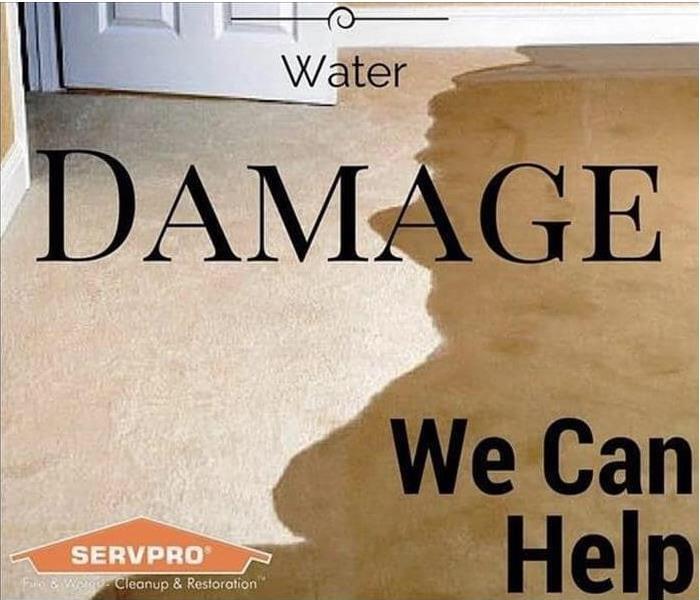 If you have water damage call us today at (781) 834-7707.
If you have water damage call us today at (781) 834-7707.
SERVPRO Marshfield/Rockland has the expertise and equipment to quickly restore your property to pre-water damage condition. We use a scientific approach to water removal and water cleanup that emphasizes monitoring and documenting the drying process from beginning to end.
Have Water Damage?
Call Today 781-834-7707
Every water damage event is a little different and requires a unique solution, but the general process stays the same. You can click on any of the steps below to learn more about that process.
Step 1 - Emergency Contact
When you call, our representative will guide you through several questions that will help us respond to your water emergency more quickly and efficiently. This initial contact is an important part of a fast, effective restoration.
Step 2 - Inspection and Water Damage Assessment
We carefully inspect your property’s water damage, determining the type of water damage and the areas affected. This is a crucial step to creating an effective plan of action that will result in a successful restoration.
Step 3 - Water Removal / Water Extraction
Typically, hundreds of thousands of gallons of water are removed using our powerful pumps and vacuums during the water removal process. We start this process as soon as possible to minimize further damage and to help prevent mold growth.
Step 4 - Drying and Dehumidification
After the bulk of the water has been removed, we use specialized equipment to target the water that’s harder to access. They use less intrusive, scientific drying methods to draw the remaining water and moisture from your property with air movers and dehumidifiers.
Step 5 - Cleaning and Sanitizing
Water damage also affects your belongings, like furniture, clothing, and personal items. We can clean restorable items using a number of specialized cleaning techniques. They also sanitize with antimicrobial treatments and remove odors using industrial air scrubbers and fogging equipment.
Step 6 - Restoration
The last step is restoring your home or business back to its pre-water damage condition. The restoration step can be relatively minor, such as replacing a few drywall panels or could include major reconstruction, such as rebuilding entire rooms of a home or business.
Marshfield Residents: We Specialize in Flooded Basement Cleanup and Restoration!
10/28/2019 (Permalink)
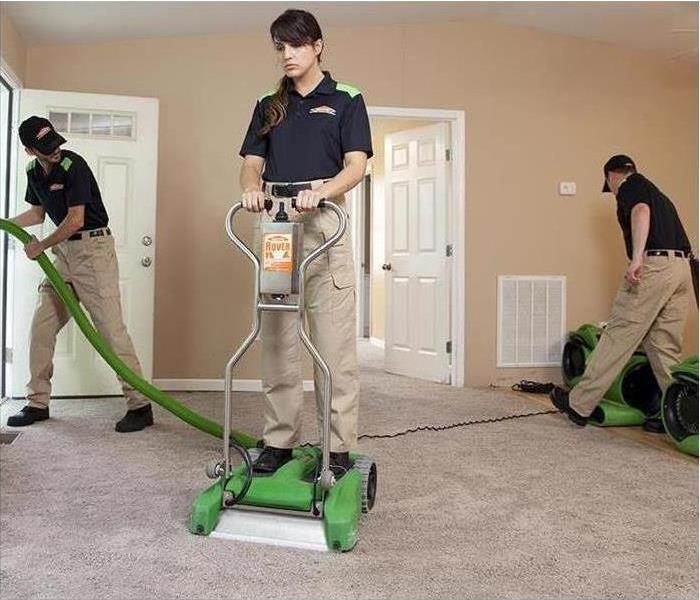 Our technicians are highly trained in water restoration techniques.
Our technicians are highly trained in water restoration techniques.
A basement can flood at any time, although flooding most often occurs during heavy rainfall. Basements are inherently prone to flooding because they are the lowest level of a building and are normally built partly or entirely below ground level. There are a number of reasons why your Marshfield or Rockland basement could flood, including:
- A blocked or failed sewer lateral pipe
- Heavy rain causes surface water to pool around your home
- Storm sewer backup
- Sanitary sewer backup
- Foundation drainage failure
- Water supply-line break or hot-water tank failure
- And many more
Have Questions about Basement Flooding?
Call Today - (781) 834-7707
If flood water is not handled quickly and properly, it can jeopardize your health and safety, and cause severe damage to your home’s structure. Remember, the longer you wait, the worse the problem will get.
The bottom line: a flooded basement can jeopardize your health, safety, and your home’s integrity. It’s worth making a call to SERVPRO of Marshfield/Rockland and let our trained, professional crews handle the situation safely and correctly. We have earned the trust of hundreds of homeowners, business owners, and property professionals.
We are Flooded Basement Specialists:
- We are Available 24 hours/7 days per week
- We’re a Preferred Vendor to many National Insurance Companies
- We Bill The Insurance Directly – One Less Thing For You To Worry About
- Our Technicians are Highly-Trained in Water Restoration Techniques
- We use s500 IICRC Restoration Standards
- Advanced Inspection and Extraction Equipment
Basement Flooded? Call Us Today – We’re Ready To Help! - (781) 834-7707
Tips For Water Damage in your Marshfield Home or Business
10/28/2019 (Permalink)
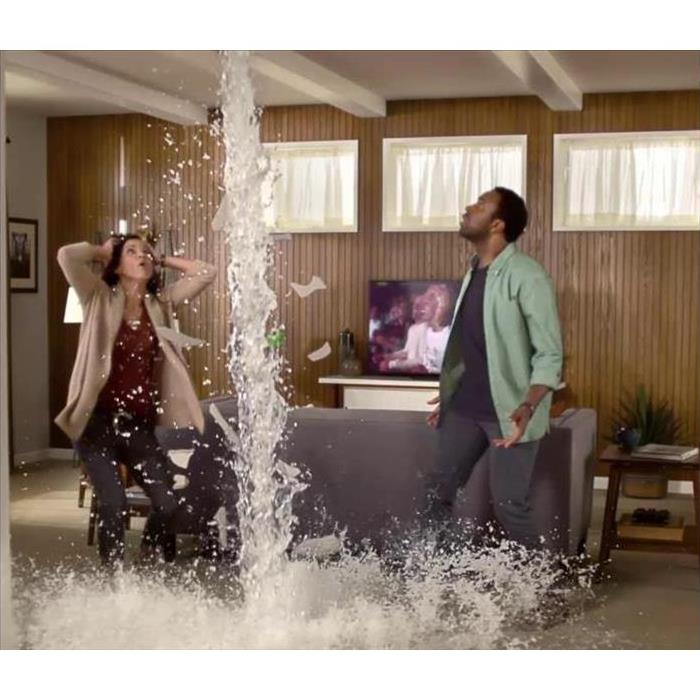 Have Water Damage? Call us today at (781) 834-7707
Have Water Damage? Call us today at (781) 834-7707
What to do until help arrives:
After any water damage situation, your primary focus should be safety:
- Is it safe to stay in the house?
- Electrical and "slip and fall" hazards are some of the most prevalent concerns.
- Only do activities that are safe for you to perform.
- Wet materials can be VERY heavy. Be careful!
What to do after Flooding:
- Remove excess water by mopping and blotting.
- Wipe excess water from wood furniture after the removal of lamps and tabletop items.
- Remove and prop wet upholstery and cushions.
- Place aluminum foil or wood blocks between furniture legs and wet carpeting.
- Turn air conditioning on for maximum drying in summer.
- Remove colored rugs from wet carpeting.
- Remove art objects to a safe, dry place.
- Gather loose items from floors.
What NOT to do after Flooding:
- Don't leave wet fabrics in place. Hang furs and leather goods.
- Don't leave books, magazines or other colored items on wet carpet or floors.
- Don't use your household vacuum to remove water.
- Don't use television or other household appliances.
- Don't turn on ceiling fixtures if the ceiling is wet, and keep out of rooms where ceilings are sagging.
SERVPRO of Marshfield/Rockland is available 24/7 with the help you need. Call us at (781) 834-7707!
Your Summer Rental has busted pipes?
5/29/2017 (Permalink)
You thought it would never happen, Memorial Day has come and gone and your summer cottage isn’t ready for summer. It might look like everyone has been on top of their game but you!
Your neighborhood has been busy getting ready for families to move in and out of their cottages for the next twelve weeks. Dumpsters have come and gone and the weekly landscapers have even been around.
You get to your property only to realize, the pipes broke over the winter. You may have walked in this morning to a very wet summer home.
Grab some towels for the sop up and call SERVPRO immediately. We are the fastest and most reliable clean up company in the area. Don’t waste more time and money not cleaning up a water mess that can ruin a floor right beneath your feet. SERVPRO is locally owned and operated and always has technicians available 24/7.
SERVPRO of Marshfield/Rockland proudly serving the South Shore area. We are here to help. Call us today!
Summer Shack Backyard Showers
5/29/2017 (Permalink)
Backyard showers and old timey bathrooms in cottages are hot spots for moisture buildup. We have plenty of crooked floors and leaky pipes on the south coast of Massachusetts!
Being the vigilant pilgrims that we are, oftentimes we fix it ourselves, moving rocks around and caulking bathroom fixtures. While it may satisfy our need to homestead, more often you need professional help.
The outdoor shower still leaks and frankly has probably damaged the shingles beyond help. We can always hope moisture and mold hasn't built up too much behind the bathtub. The very best thing you can do to keep your cottage ready for weekend fun and money-making rentals is to call SERVPRO.
Do you own a property in Eastern Massachusetts along the coast? Are you concerned about water damage and mold? Call SERVPRO, we are the fastest and most reliable, locally owned and operated clean up service in Eastern Massachusetts.
Call us today and get your Summer Shack back in tip top money making shape!
Mother Nature and Freak Accidents Part 2
3/11/2017 (Permalink)
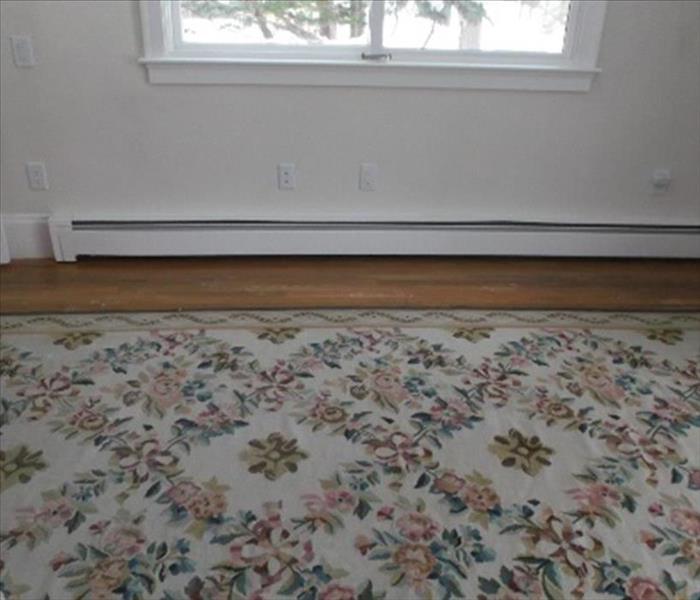 Avoid damaging your floors/sub-floors underneath and further costly damage by using the best professional services available to you.
Avoid damaging your floors/sub-floors underneath and further costly damage by using the best professional services available to you.
The best thing you can do to save that area rug you love so much, is to roll it up BEFORE the storm. If you’ve been warned of possible flooding, take the extra time to put away your mats and area rugs that you can.
Textiles that have been underwater for 24 hours should be considered trash, they are unrecoverable and have already started going mold and bacteria. That being said, when the water is out of your control, there is hope for your carpets ~ if you move quickly.
Carpet recovery is NOT a do it yourself job. Immediately call a professional. While you’re waiting you can sop up excess water with towels and remove any large debris from the floor. Do not lift carpet that is tacked to the floor, this can cause shrinkage that can ruin the product. While carpet padding often cannot be dried quickly enough to prevent spore growth, calling SERVPRO of Marshfield/Rockland for their professional drying services can be your best chance of saving your carpet.




 24/7 Emergency Service
24/7 Emergency Service

